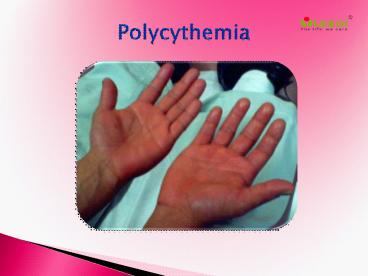Polycythemia: Causes, Symptoms and Treatment (1) - PowerPoint PPT Presentation
Title:
Polycythemia: Causes, Symptoms and Treatment (1)
Description:
Polycythemia is a rare bone marrow disorder, which causes the increase in the production of cells in the blood, mainly red blood cells. – PowerPoint PPT presentation
Number of Views:742
Title: Polycythemia: Causes, Symptoms and Treatment (1)
1
Polycythemia
2
Polycythemia
- Polycythemia is a rare bone marrow disorder,
which causes the increase in the production of
cells in the blood, mainly red blood cells. The
primary function of the red blood cells is to
carry oxygen to the different parts of the body.
This blood disorder affects more men than women.
The excess production of red blood cells makes
your blood too thick, which affects the normal
flow of blood in the body and may even lead to a
stroke or a heart attack. This disease develops
gradually over a time. With the increase in red
blood cells, there may also be an increase in the
production of white red blood cells and platelet
count.
3
Causes of Polycythemia
- The most common cause of Polycythemia is
genetic. The patient of Polycythemia may have
inherited a gene called, JAK2, the function of
this gene is to keep the production of red blood
cells and other blood cells under control.
However, the exact cause of Polycythemia is not
known. Here are some of the common conditions
that may increase the chance of Polycythemia - Heart failure
- Lack of blood flow in the kidneys
- Hypertension
- Sleep apnea
- Pulmonary disease
4
Symptoms
- The symptoms of Polycythemia can be easily
treated if, detected early. No proper treatment
of Polycythemia in it early stage can lead to
fatal complications in future. Symptoms of
early PolycythemiaWeakness - Weight loss
- Headache
- Swelling in joints
- Dizziness
- Itchiness
- Symptoms of Polycythemia if left untreated in
early stage - Heart attack
- Stroke
- Deep vein thrombosis
- Loss of blood supply to brain
- Internal bleeding
5
Diagnosis of Polycythemia
- The most common method of diagnosing Polycythemia
is a blood test. A doctor may refer a blood test
known as CBC (Complete Blood Count). - A complete blood test is performed by taking
blood samples from the patients vein. The
complete blood test (CBC) evaluates the amount of
red blood cells, white blood cells and blood
platelets. - Bone marrow biopsy is a procedure in which a
sample of bone marrow generally taken from the
back of your hipbone is observed under medical
supervision.
6
Treatments
- The treatment of Polycythemia varies from
patient to patient. The aim of the treatment is
to lower the production of red blood cells in
your bone marrow. The treatment of Polycythemia
include - Phlebotomy- In this procedure the excess blood in
the patients body is removed from their vein, to
make present blood less thick so it can flow
better. - The specialised treatment of Polycythemia
involves using, Hydroxyurea and interferon alpha.
These medicines, suppresses the risk of blood
clots by reducing the excessive production of red
blood cells. However, the patients of thyroid
and mental disorders are, advised not to take
interferon alpha.
7
CONNECT WITH US
- Logon to
- www.lazoi.com
- Like us on Facebook
- https//www.facebook.com/LazoiTheLife
- Follow us on Twitter
- https//www.twitter.com/lazoithelife
- Follow us on Pinterest
- https//www.in.pinterest.com/lazoithelife































